What Is Rheumatoid Arthritis?

Rheumatoid arthritis (RA) is an autoimmune disease in which the body attacks the lining tissue of joints, causing chronic joint inflammation. While it primarily affects joints, it can also cause inflammation of organs, such as the lungs, eyes, skin, and heart.
People with RA may experience an increase in symptoms, called "flares," that can last for days or weeks. They may also have periods of remission where they have few or no symptoms. There is no cure for rheumatoid arthritis, but medications can stop the progression of the disease and ease symptoms.
Rheumatoid Arthritis: Are You at Risk?

According to the Arthritis Foundation, rheumatoid arthritis affects about 1.5 million people in the U.S. Women are three times more likely to develop RA than men. Symptoms in women tend to appear between the ages of 30 and 60, while symptoms often develop after age 45 in men.
There may also be a genetic basis for the disease. Cigarette smoking and gum disease (periodontitis) are also risk factors.
Juvenile Rheumatoid Arthritis (JRA)

Juvenile rheumatoid arthritis (JRA), also called juvenile idiopathic arthritis (JIA), is a type of arthritis that occurs in children ages 1 to 16.
Juvenile Rheumatoid Arthritis Symptoms
- Stiff, swollen, painful joints
- Fever
- Rash
Juvenile Rheumatoid Arthritis Diagnosis
For a JRA diagnosis, the child's symptoms must last at least six weeks.
Healthy Joints vs. Arthritic Joints
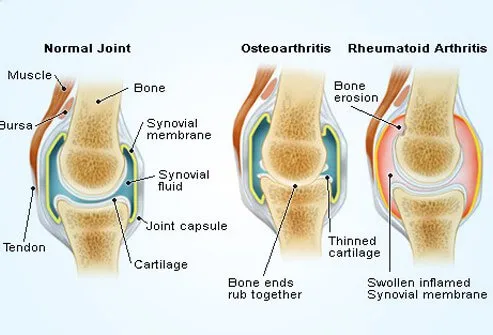
Arthritis may refer to more than 100 conditions that affect the musculoskeletal system. Your joints are the places where your bones meet. When arthritis is present, your joints may become inflamed, stiff, red, and painful. Damage from RA may occur in tissues surrounding the joints, including the tendons, ligaments, and muscles. RA is one type of arthritis classified as "systemic," meaning it can occur throughout your body. In some patients, symptoms may extend to the skin and eyes, as well as internal organs, including the lungs, kidneys, heart, and liver.
What Causes Rheumatoid Arthritis?

The exact cause of RA remains unknown, but several risk factors have been identified. Women are diagnosed with RA more often, and it is suspected that the hormone estrogen may play a role. Several studies have shown there is a genetic component to developing RA. Cigarette smoking appears to increase the risk of developing the disease. Occupational exposure to certain dusts such as silica, wood, or asbestos can also lead to a higher risk for developing the illness. Some think there is a viral or bacterial cause of RA but that is still being studied.
Rheumatoid Arthritis Symptoms: Joint Pain

With RA, hands are almost always affected. However, RA can affect any joint in your body, including wrists, elbows, knees, feet, hips, and even the jaw. Usually, joints are affected symmetrically, meaning the same joints on both sides of the body are affected. Rheumatoid arthritis can be very painful, and chronic inflammation can lead to debilitating loss of cartilage, bone weakness, and joint deformity.
Rheumatoid Arthritis Flares

When a person with RA has symptoms including joint inflammation and pain, this is called a flare. Flares may last from weeks to months. This can alternate with periods of remission, when symptoms are minimal to nonexistent. Periods of remission can last weeks, months, or even years. After a period of remission, if the symptoms return this is called a relapse. It is common for RA patients to have periods of flares, remissions, and relapses, though the course of the illness varies with each patient.
Rheumatoid Arthritis Symptoms

In addition to the hallmark symptoms of swollen, painful, and stiff joints and muscles, patients with RA may also experience other symptoms.
Other Symptoms of Rheumatoid Arthritis
- Fatigue
- Low-grade fever
- Lack of energy
- Loss of appetite
- Bumps under the skin (rheumatoid nodules)
- Shortness of breath due to inflammation or damage to the lungs
- Hoarseness
- Eye problems
In addition to these symptoms, muscle and joint stiffness of rheumatoid arthritis is usually worse in the morning and after extended periods of inactivity.
Rheumatoid Arthritis Symptoms: Inflammation of Organs
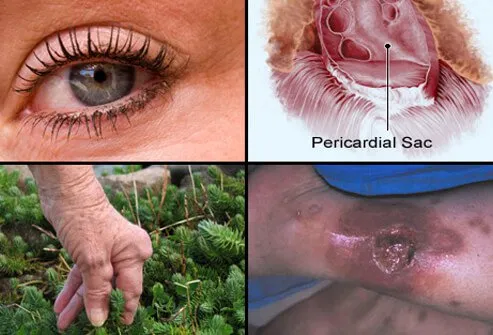
Rheumatoid arthritis is a systemic disease, meaning it can affect the entire body. In addition to the joints and muscles, RA can cause problems in many other areas of the body:
- Eyes and mouth: inflammation of the glands in the eyes and mouth causes dryness, and an autoimmune disease of the tear and saliva glands called Sjogren's syndrome. It can also lead to inflammation of the white part of the eye (scleritis).
- Lungs: inflammation of the lung lining (pleuritis) or the lungs themselves can cause shortness of breath and chest pain.
- Heart: inflammation of the tissue surrounding the heart (pericarditis) can cause chest pain, which tends to be worse when lying down. RA patients are also at greater risk for heart attacks.
- Spleen: inflammation of the spleen (Felty's syndrome) can cause a decrease in white blood cells, which raises the risk of infections.
- Skin: firm lumps under the skin (rheumatoid nodules), typically located around affected joints, often on pressure points such as elbows, fingers, and knuckles.
- Blood vessels: inflammation of the blood vessels (vasculitis) can limit blood supply to surrounding tissues, causing tissue death (necrosis).
What Is a Rheumatologist?

A rheumatologist is usually an internal medicine specialist or pediatrician, with specialized rheumatology training to identify and treat the more than 100 different types of arthritis in addition to other autoimmune disorders such as lupus, polymyositis, and vasculitis.
Rheumatoid Arthritis in Hands
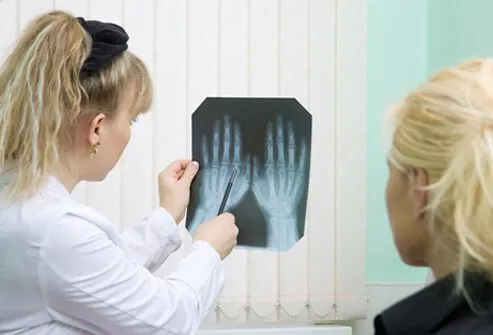
There is no singular test to diagnose rheumatoid arthritis. First, the doctor will perform a physical and take a history of symptoms. The joints will be examined to determine if there is inflammation and tenderness. The heart, lungs, eyes, mouth, and extremities will be evaluated. And the skin may be examined to look for rheumatoid nodules. The doctor may order blood tests or X-rays to help diagnose the condition.
Many other diseases such as gout, fibromyalgia, and lupus may resemble rheumatoid arthritis, so the doctor will rule out these conditions before making a diagnosis of RA.
Rheumatoid Factor & Blood Tests
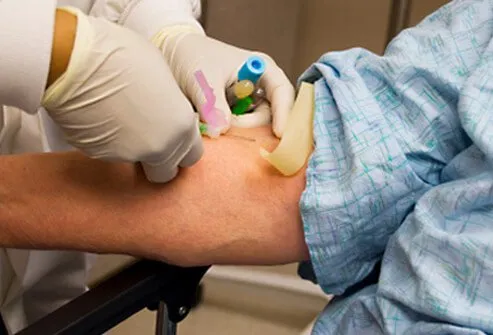
Blood tests are usually run to help make a diagnosis of rheumatoid arthritis. These tests check for certain antibodies including anti-cyclic citrullinated peptide antibodies (ACPA), rheumatoid factor (RF), and antinuclear antibodies (ANA), which are present in most RA patients.
Rheumatoid factor (RF; a group of antibodies that attack the person’s tissue;) is present in about 75% to 80% of RA patients, and a high RF may indicate a more aggressive form of the disease. Antinuclear antibodies (ANA) is not specific for a diagnosis for RA, but their presence can indicate to the doctor that an autoimmune disorder may be present.
Sedimentation Rate (Sed Rate)
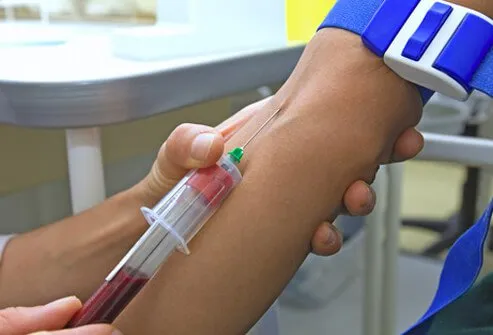
Other blood tests that may be run can help the doctor determine the extent of the inflammation in the joints and elsewhere in the body. The erythrocyte sedimentation rate (ESR, or "sed rate") measures how quickly red blood cells fall to the bottom of a test tube. Typically, the higher the sed rate, the more inflammation there is in the body.
Another blood test that measures inflammation is the C-reactive protein (CRP) test. If the CRP is high, inflammation levels are usually high as well, such as during a flare of rheumatoid arthritis.
Imaging Tests
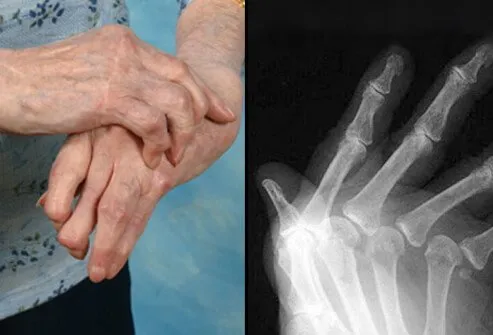
Another test used to diagnose rheumatoid arthritis is X-ray. Early in the disease, X-rays can be helpful as a baseline test and they can be useful in later stages to monitor how the disease progresses over time. Other imaging tests used include ultrasound and magnetic resonance imaging (MRI).
Arthrocentesis

A joint aspiration procedure (arthrocentesis) may be performed to obtain joint fluid to test in the laboratory. A sterile needle and syringe are used to drain fluid from the joint, which is then analyzed to detect causes of joint swelling. Removing this joint fluid can also help relieve joint pain. Sometimes, cortisone may be injected into the joint during the aspiration procedure for more immediate relief of inflammation and pain.
Osteoarthritis vs. Rheumatoid Arthritis

Currently, there is no cure for rheumatoid arthritis, but there are several medications that can ease its symptoms. Most treatments are aimed at remission, where the patient has few or no symptoms of RA. When treatment is started early in the disease process, this can help minimize or slow damage to the joints and improve quality of life for patients. Treatment usually involves a combination of medication, exercise, rest, and protecting the joints. Sometimes, surgery may be needed.
Medications
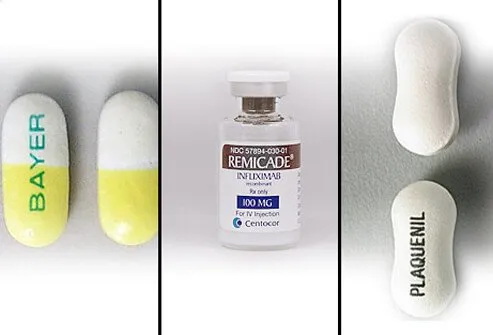
If you are diagnosed with rheumatoid arthritis, the sooner the treatment begins, the better your outcome is likely to be. There are many different medications used to help alleviate symptoms of RA and with the goal of bringing a patient into remission.
Common Drugs for Rheumatoid Arthritis
- Disease-modifying antirheumatic drugs (DMARDs) such as methotrexate, hydroxycholoquine (Plaquenil), sulfasalazine (Azulfidine, Azulfidine EN-Tabs), leflunomide (Arava), and azathioprine (Imuran)
- Biologic response modifiers (another type of DMARD) such as abatacept (Orencia), adalimumab (Humira), anakinra (Kineret), certolizumab and pegol (Cimzia) etanercept (Enbrel), infliximab (Remicade), golimumab (Simponi), and rituximab (Rituxan)
- Nonsteroidal anti-inflammatories (NSAIDs) such as ibuprofen (Advil, Motrin), ketoprofen (Actron, Orudis KT), naproxen sodium (Aleve), and celecoxib (Celebrex)
- Janus kinase (JAK) Inhibitor – a new drug called tofacitinib (Xeljanz)
- Corticosteroids
- Analgesics (painkillers)
Drugs used to reduce pain (analgesics) and inflammation (NSAIDs) are often considered "first-line" drugs as they are fast-acting and can relieve symptoms quickly. Medications such as DMARDs and biologic drugs take longer to have an effect, but they can help prevent inflammation and joint damage.
Diet and Rheumatoid Arthritis

While there is no special diet people with rheumatoid arthritis should follow, eating a healthy, balanced diet is always recommended, and some foods may help ease inflammation.
- Omega-3 fatty acids found in fish oil may offer anti-inflammatory benefits, so fish such as herring, mackerel, trout, salmon, and tuna may be a part of a healthy diet. If you choose to take fish oil supplements, check with your doctor for the proper dosage.
- Extra fiber from fruits, vegetables, and whole grains can result in a lower C-reactive protein (CRP) in the blood. High levels of CRP indicate inflammation.
- Vitamin D may help lower the risk for RA in women. Eggs, fortified breads and cereals, and low-fat milk contain Vitamin D.
Rheumatoid Arthritis Treatment for Other Parts of the Body
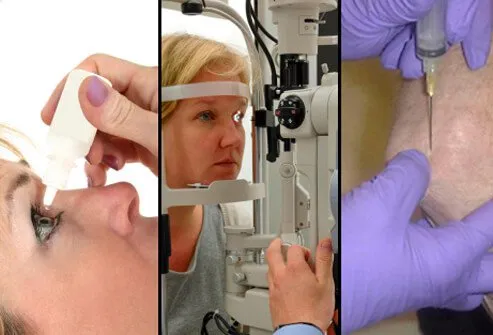
Rheumatoid arthritis can also affect other areas of the body, and these symptoms may be treated individually.
- Sjogren's syndrome can cause eye dryness and may be treated with eye drops to moisturize, and also drops to increase tear production such as cyclosporine (Restasis). Dry mouth related to Sjögren's may be treated with certain mouthwashes and toothpastes.
- Inflammation of the lung lining (pleuritis) or the lungs themselves may require treatment with corticosteroids.
- Inflammation of the tissue surrounding the heart (pericarditis) usually requires keeping the overall inflammation levels down and many RA drugs can help.
- Inflammation of the spleen (Felty's syndrome) can cause a decrease in white blood cells, which raises the risk of infections and may be treated with a stimulating factor (granulocyte stimulating factor/GSF) used to increase the amount of white blood cells.
- Rheumatoid nodules may require injections of steroids, or surgery to remove them if they are severe.
- Inflammation of the blood vessels (vasculitis) may be treated with painkillers, antibiotics, and protecting the areas affected.
Rheumatoid Arthritis Treatment: Physical Activity and Rest
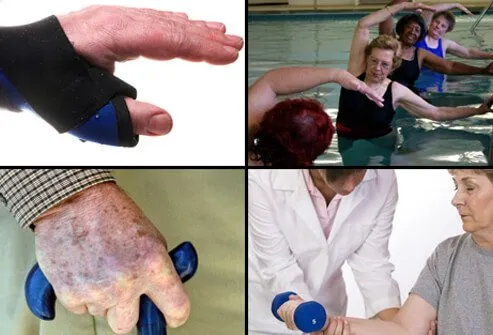
A balance of physical activity and rest periods are important in managing rheumatoid arthritis. Exercise more when your symptoms are minimal, rest more when your symptoms are worse.
Exercise and Rheumatoid Arthritis
Exercise helps maintain joint flexibility and motion. There are therapeutic exercises with physical therapy that is prescribed, that can help with strength, flexibility, and range of motion of specific joints or body parts affected by your RA. Many recreational activities such as walking swimming are helpful because allow movement with little to no impact on the joints. Consult your rheumatologist or physical therapist to find out what exercises are right for you.
Types of Exercises for Rheumatoid Arthritis
Physicians often recommend the following sports and exercises for their relatively low-stress impact on joints.
- Walking
- Bicycling
- Swimming
- Movement (yoga, tai chi, etc.)
- Strength building
Just as physical activity is important, so is rest. When you have an RA flare and your symptoms are worse, it is best to reduce your activity to help minimize joint inflammation and pain, and to cope with fatigue.
Surgery for Rheumatoid Arthritis
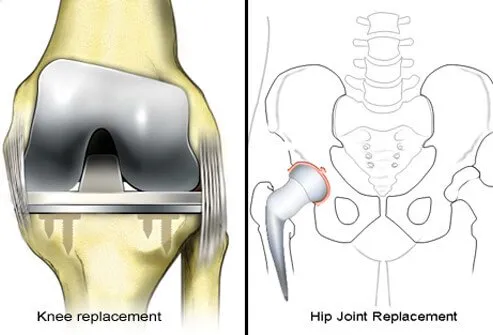
With severe rheumatoid arthritis, surgery may be needed to reduce pain and improve joint function. Some surgeries include joint replacement, fusion of joints (arthrodesis), tendon reconstruction, and removal of inflamed tissues (synovectomy). Discuss your treatment options with your doctor to find out what is right for you.
What Is Rheumatoid Arthritis (RA)? Symptoms, Treatment, Diagnosis
This tool does not provide medical advice. See additional information: 
© 1996-2024 WebMD, LLC. All rights reserved.
